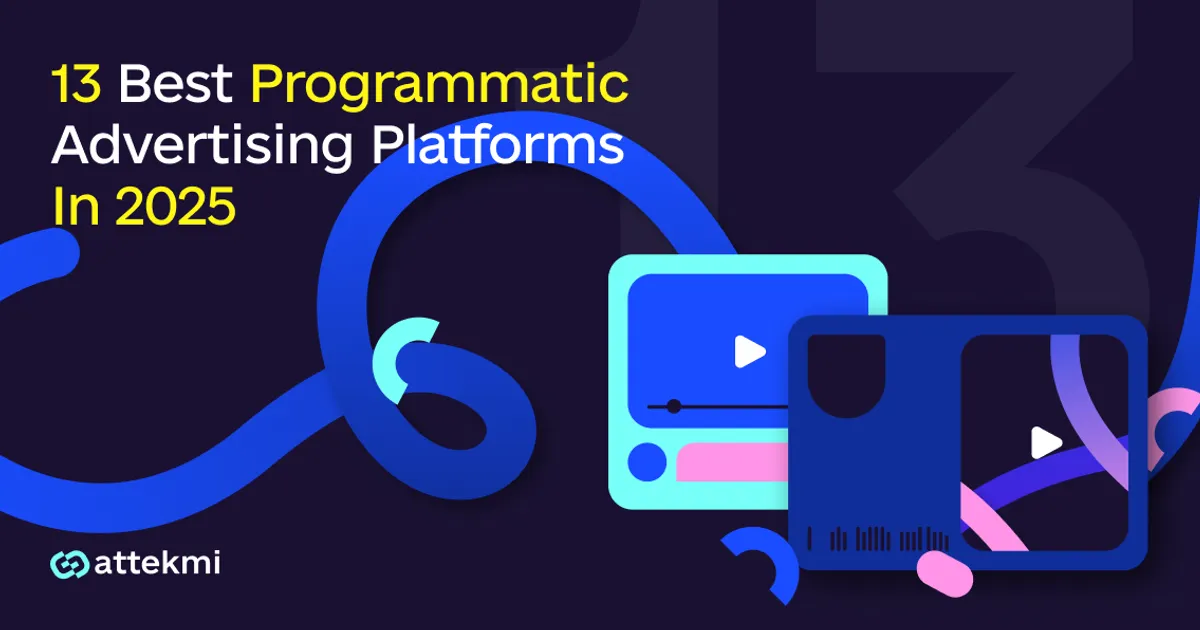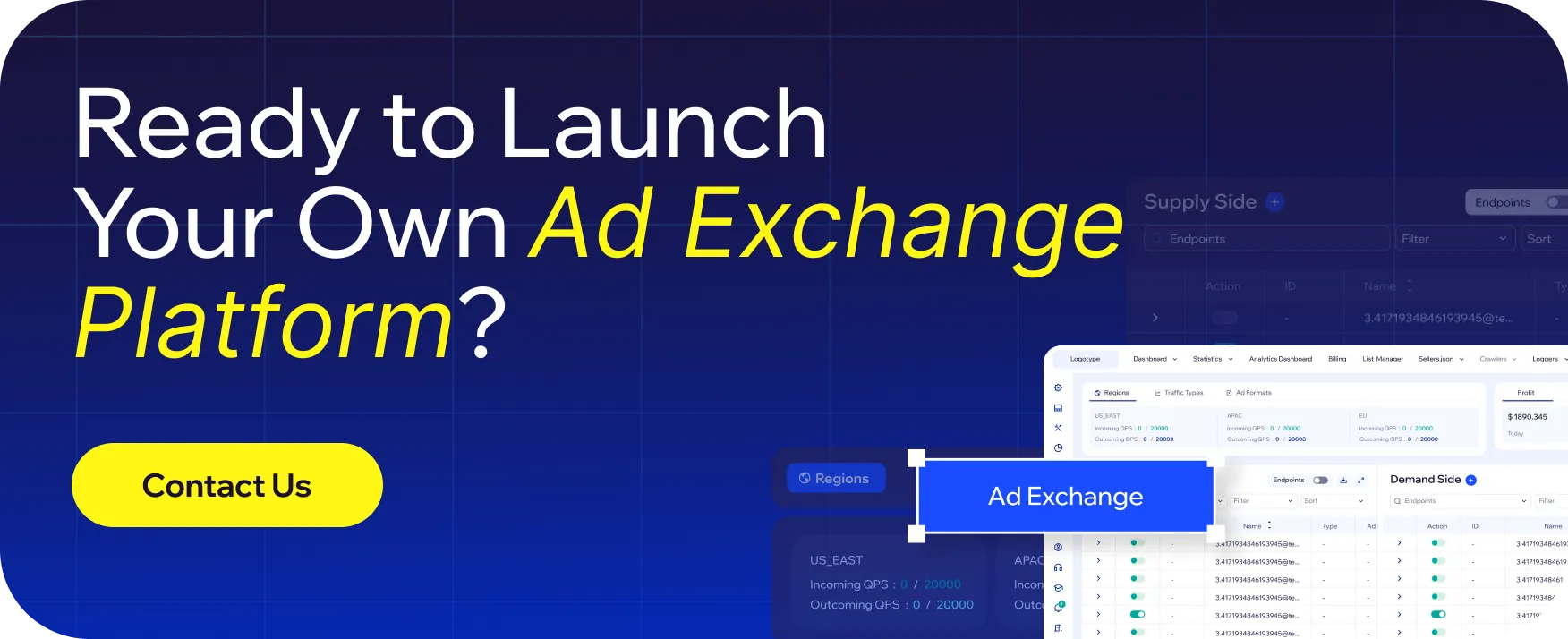Investments in programmatic advertising keep growing. According to Statista, global programmatic ad spend is projected to reach almost $780 billion by 2028, while in 2022 it was approximately $490 billion.
This tendency is easy to explain. Programmatic technology enables marketers to purchase ad inventory in a fast and convenient way and reach exactly those users who are most likely to convert. In turn, publishers get an opportunity to monetize their inventory and provide users with relevant experience. Owners of ad exchange solutions can also earn on media trading by matching supply and demand partners.
However, there are so many programmatic advertising companies nowadays that making a choice can turn out to be challenging. To help you, we have prepared a list of top programmatic advertising companies – keep reading to learn more!
Key Takeaways
Programmatic ad spending continues to surge, projected to reach around $780B by 2028, driven by automation, precise targeting, and real-time optimization.
Marketers benefit from increased efficiency and ROI, while publishers and ad exchange owners can monetize and scale effectively.
Top platforms like The Trade Desk, SmartyAds, StackAdapt, and Criteo offer robust solutions for various formats (CTV, DOOH, native, audio) and use cases.
Each platform has its strengths: some are more suitable for publishers (e.g., Publift, TripleLift), others for advertisers (e.g., Choozle, AdRoll), or both sides (e.g., Smaato, MediaMath).
Attekmi stands out by offering not only customizable ad exchange technology but also White Label solutions, AdTech development, Ad Ops outstaffing, and team training, making it a full-spectrum partner in the programmatic ecosystem.
Choosing the right platform depends on your goals: ad monetization, campaign efficiency, custom development, or full-stack control.
How we selected these programmatic advertising companies
When creating our list of best programmatic advertising platforms, we checked not only the key features, such as the supported ad formats. We also explored the availability of identity solutions, AI capabilities, fraud protection mechanisms, and other features. In the modern AdTech ecosystem, such capabilities matter as the impact of AI keeps growing, while privacy regulations are getting stricter. Besides, fraudulent tactics evolve continuously, so the availability of detection and prevention functionalities is a great benefit. We also looked for special advantages, like, for instance, an intuitive user interface. Below, you can see the results of our search for the best programmatic ad platforms and companies.
Top 13 programmatic advertising platforms
So, now it is time to explore the most effective programmatic ad companies to consider in 2025! Here they are:
1. AdForm
AdForm is a programmatic advertising company offering an entire set of products for marketers and publishers. It includes not only a demand-side platform and a supply-side platform, but also an ad server, data management platform, and so on.
Key Features:
All formats are supported
Dynamic creative optimization
Detailed analytics and reporting
Identity solutions instead of third-party cookies
Audience composition and discovery
Pricing:
Not provided
Pros:
Demo is available
Sustainable trading for reducing your carbon footprint
Multiple awards
Cons:
Some users reported targeting issues
2. SmartyAds
SmartyAds is a programmatic advertising company that offers an entire range of products: a DSP, an SSP, and so-called Curated Deals – special packages from top direct publishers.
Key Features:
Banner, video, native, rich media, audio, and DOOH formats
Desktop, mobile web, in-app, and CTV environments
Advanced targeting and filtering capabilities
RTB and direct deals
Header bidding
Analytics
Pricing:
The first minimum prepayment for DSP users is $1,000
The amount for subsequent prepayments is $500
CPM (cost per mille) model
Pros:
Solutions for both publishers and advertisers
A variety of programmatic buying models
Optimization features
Multiple awards
Trusted supply partners
Cons:
Navigation is easy but you may still need some time to get used to the platform in case you are new to programmatic advertising
3. The Trade Desk
The Trade Desk is the omnichannel advertising platform offering programmatic ad services for media buyers. Other useful tools (like identity solutions) are on the list as well.
Key Features:
Audio, video, display, native display, native video, TV, and DOOH formats
AI-enhanced media buying
Access to premium inventory
A variety of targeting settings
Analytics
Pricing:
Varies
Pros:
Detailed product documentation
Intuitive user interface
Forecasts for the impact of every change you make
A course from The Trade Desk Edge Academy to help you get used to the platform
Cons:
According to some reviews, you may face reporting issues
4. Publift
Publift is a programmatic ad company focusing specifically on publishers and offering them website monetization opportunities.
Key Features:
An impressive variety of ad formats: banner, in-content, sticky, web interstitial, interscroller, and other ads
Identity solutions instead of third-party cookies
Yield optimization
Price algorithm optimization
Hybrid bidding
Context classification tool
Ad block monetization
Pricing:
Custom plans
Pros:
Demo is available
A built-in consent management platform
Access to premium demand partners
Cons:
You need to meet a set of requirements – for instance, Publift usually partners with publishers generating over $2,000 per month
5. Nexxen
In terms of programmatic ad platforms, Nexxen offers an impressive variety of solutions: a demand-side platform, a supply-side platform for publishers, an SSP for buyers, a curated marketplace, etc.
Key Features:
Video, display, and audio formats
Contextual and cohort-based targeting
A forecasting tool for budget planning
Reporting
Private marketplaces
Creative analysis and insights
Pricing:
Not provided
Pros:
A unified platform
Direct access to premium publishers and broadcasters
Access to TV Intelligence viewership data
Sustainable solutions to minimize carbon emissions
Cons:
Nexxen prioritizes CTV advertising, so, for instance, DOOH marketing is not possible
6. Criteo
Another company delivering programmatic ad services is Criteo – it offers a variety of solutions for both the demand and supply sides.
Key Features:
Video, dynamic, adaptive, showcase, rich media, image, and other formats
Retargeting
Dynamic creative optimization
Predictive bidding
Contextual advertising
Pricing:
Performance-based
Pros:
An all-in-one platform
Scalability
AI engine
5 billion ads are served per day
Cons:
Regulatory operating costs targeting France, Spain, and Italy
7. Smaato
Among many other programmatic advertising solutions, Smaato stands out due to its impressive selection of solutions and tools. Besides, it has something to offer to both advertisers and publishers.
Key Features:
Native, video, display, CTV, and OTT ads
All sizes and environments are supported
Fraud protection
A consent management platform is available
Analytics
Pricing:
No ad serving fees
Pros:
A variety of programmatic models: RTB, PMP, in-app header bidding, preferred deals, and programmatic guaranteed
Multiple integration options
Pre-packaged deals
The platform is customizable
Cons:
According to some reviews, navigation may be confusing
8. MediaMath
MediaMath offers a range of solutions, and a programmatic platform for advertisers is on the list.
Key Features:
CTV, DOOH, video, display, native, and audio formats
Dynamic budget allocation
Advanced targeting settings
Fraud protection
Reporting and measurement
Pricing:
Not provided
Pros:
Access to top publishers
Demo is available
Customizable tech stack
Identity management
Cons:
Some reviews specify that the platform still has certain bugs
9. AdRoll
AdRoll is another programmatic advertising platform focusing exactly on advertisers and trusted by over 140,000 brands.
Key Features:
Display, video, native, CTV, and social ads
Retargeting
Dynamic creative optimization
Advanced audience modeling and targeting
Analytics
Pricing:
Pay-as-you-go package (some functionalities are not available)
Advanced package with custom quote
Pros:
Self-service and managed services options
Multiple awards
Consent banner integration
Some free tools are available
Cons:
Some users report ad management issues
10. TripleLift
Focusing primarily on publishers, the TripleLift programmatic platform provides them with an opportunity to monetize their inventory effectively.
Key Features:
Native, video, display, CTV, and other formats
Desktop, mobile, and CTV environments
Advanced targeting
Adaptive templates
AI detection
Pricing:
Not provided
Pros:
Access to premium demand
Seamless integration of the ads
Brand safety
Pre-bid integrations are supported
No traffic requirements
Cons:
No demo available
11. StackAdapt
StackAdapt is a programmatic solution for advertisers enabling them to reach publishers effectively.
Key Features:
Native, display, video, CTV, audio, in-game, and DOOH formats
Ad Previewer to check how your creatives will be displayed
Creative Studio to tailor your ads
Private marketplace
Testing capabilities
Contextual targeting
Analytics and reporting
Pricing:
Not provided
Pros:
Intuitive UI
Demo is available
Free online programmatic courses
Cons:
According to some reviews, reporting capabilities are limited
12. Choozle
Choozle is one more programmatic platform offering solutions specifically to marketers.
Key Features:
Display, DOOH, video, audio, CTV, native, search, and social media formats
Comprehensive targeting settings
Automated AI optimization
Cross-device support
Third-party integrations
Ad fraud prevention
Reporting and analytics
Pricing:
Various pricing models
Pros:
An all-in-one platform
Access to premium ad inventory
Demo is available
Managed and self-service options
Cons:
Some users mention poor reporting
13. Attekmi
The programmatic advertising services listed above provide you with loads of opportunities! However, you may still have some special requirements. If so, the Attekmi team would be happy to help.
Apart from a range of ad exchange solutions (including a fully customizable White Label ad exchange platform), Attekmi offers custom AdTech development services. We can build for you a DSP, an SSP, a data management platform, or any other solution you may need. Just provide us with your requirements, and our skilled and experienced professionals will bring your project to life.
Besides, with our ad exchange solutions, you can match demand and supply and earn on media trading.
Key Features:
Banner, video, audio, native, and CTV formats
Desktop, in-app, mobile web, and CTV environments
Multiple targeting and filtering settings
A variety of QPS plans
A wide range of integration types, including VAST to RTB
The Demand Booster feature for profit optimization
Analytics and reporting
Ad fraud prevention
Pricing:
Custom plans
Pros:
A wide selection of ad exchange solutions
Regular introduction of new features according to customer feedback
An ad server solution
Custom AdTech development services
Ad Ops outstaffing services
AdTech and AdOps team training services
Customer support
Multiple awards
Cons:
You may need some time to get used to the platform
With an ad exchange from Attekmi, Toucan Ads managed to achieve 682% profit growth!
Key features to look for in a programmatic partner
When choosing between different programmatic marketing companies, you should pay special attention to the following functionalities and characteristics:
Cross-channel support. To succeed, you need to create an omnichannel strategy, so your platform should support diverse environments.
Transparent reporting. You need clear and detailed analytics to optimize your strategy effectively.
Brand safety functionalities. Advanced filtering settings, fraud prevention tools, and other relevant capabilities are essential to protect your reputation and budget.
Optimization functionalities. Depending on the required type of solution, such features can help you optimize your spend, drive greater income, adjust your strategy more effectively, etc.
Platform frequency update. You want your solution to remain effective, so choose the one that is regularly updated with new functionalities.
Support service. To make the most of your platform, prefer an AdTech partner who will be able to help you with any challenges and questions.
Conclusion
We provided you with a list of top programmatic advertising platforms, so now it will be easier for you to make a choice. The first step you need to take is to define your goals. What do you need an AdTech solution or partner for? What are the key features that you require to achieve your goals? Answering these questions will help you shorten the list of potential solutions. Besides, make sure to look for reviews on reputable third-party platforms like G2 or Clutch. This can help you make the final decision when choosing between top-rated programmatic advertising firms.
FAQ
To choose between programmatic ad companies, explore the key features while paying special attention to optimization, reporting, and brand safety functionalities. Cross-channel support, as well as platform frequency update and support service, matter as well.
When reviewing a range of programmatic marketing companies, consider the transparency factor. This applies to pricing, data usage, compliance, analytics, and other aspects. Complete transparency enables you to build a long-lasting collaboration with your AdTech partner and ensure more effective optimization decisions.
In 2025, programmatic advertising is shaped by first-party data strategies, AI-driven optimization, and the rise of programmatic direct deals. Privacy-first measurement, attention metrics, and sustainability initiatives are turning into priorities. Besides, connected TV (CTV) and digital out-of-home (DOOH) channels continue to grow, creating a more effective cross-channel programmatic ecosystem.
 By Iryna Kozirevych
By Iryna Kozirevych
